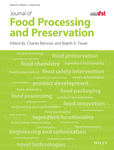A comparative study of the nutritional values, volatiles compounds, and sensory qualities of pea pastes cooked in iron pot and clay pot
Funding information: Science and Technology Development of Shaanxi Province (Overall Planning project), Grant/Award Number: 2014KTZ1302-01-01
Abstract
In the current study, the nutritional values, volatiles compounds, and sensory qualities of pea pastes cooked in iron pot and clay pot were compared. Results showed that the iron pot-cooked pea pastes contained profoundly more iron, total sugar, and starch than the clay pot-cooked ones, and the effects were found related to iron ion by comparing the results between clay pot-cooked pastes with and without iron ion addition. Samples prepared with the two utensils demonstrated similar contents of protein, polyphenol, and tannin, but differed in the composition of some volatile alcohols, alkanes, aldehydes, ketones, esters, and organic acids. The clay pot-cooked samples had higher score of “color,” “mouthfeel,” “taste,” and “overall quality” than the iron pot-cooked pastes. In conclusion, iron pot can allow the production of iron-enriched pea pastes whose sensory qualities are remarkably lower than those of the clay pot-cooked samples but are still in the acceptable range.
Practical applications
Iron utensil plays an important role in modern food industry due to its durability and convenience to handle. Cooking with iron pot is a simple and useful method of dietary iron fortification for the prevention of iron-deficiency anemia in developing countries. Pea paste is a popular legume food with high nutritional value and good palatability. Traditional pea paste producers believe cooking with clay pots can give rise to product with more desirable features than using iron pots. However, there were no scientific evidences regarding the effects of cooking utensils on pea paste qualities. It has been proved in the current study that iron pot can allow the production of iron-enriched pea pastes whose sensory qualities are remarkably lower than those of the clay pot-cooked samples but are still in acceptable range.




